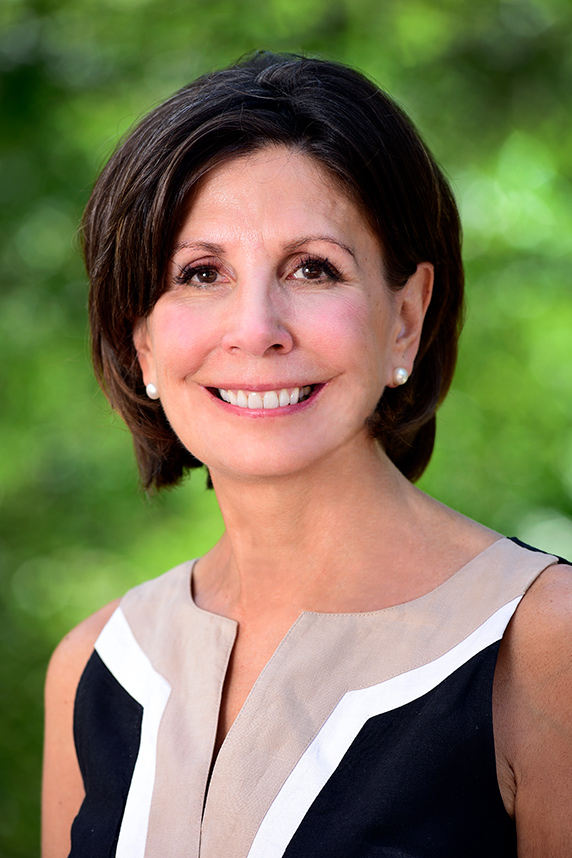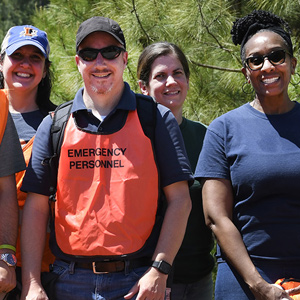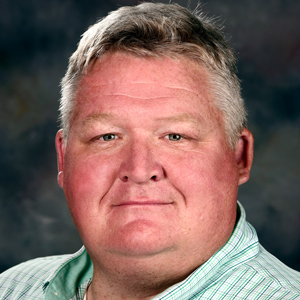NIEHS learned April 30 that the institute extended its run of Green Champions awards from the U.S. Department of Health and Human Services (HHS) to a ninth year, with appearances in three different categories for 2018. HHS Green Champions are individuals who take on the challenge of reducing energy use, saving natural resources, and minimizing the carbon footprint of the federal government.
- Environmental Management System (EMS) Awareness Training Project — group
- Vivarium Water Reduction Project — group
- National Institutes of Health (NIH) Green Labs Program — individual as part of group
“We pride ourselves on being the environmental institute, and these awards reflect the importance of these efforts and how our employees are working together to make our workplace more sustainable,” said NIEHS and National Toxicology Program Director Linda Birnbaum, Ph.D., when she announced the awards to the institute.
Environmental Management System (EMS) Awareness Training Project
 Steinmetz noted that launch of the new training video was smooth, despite added technical features. (Photo courtesy of Steve McCaw)
Steinmetz noted that launch of the new training video was smooth, despite added technical features. (Photo courtesy of Steve McCaw)Paul Cacioppo, David Christie, Bill Fitzgerald, Tony Hall, Paul Johnson, John Maruca, Joe Poccia, Ann Thompson, Bill Steinmetz
The NIEHS Health and Safety Branch, the Office of Communications and Public Liaison (OCPL), and its contractors teamed up to produce a unique web-based interactive training program to support efforts to reduce environmental impacts, increase awareness of sustainable practices, and promote our campus EMS.
“The award recognizes an excellent online training that effectively shows employees how their work practices impact the environment,” Birnbaum said.
The new website is more user-friendly than the old system, according to Steinmetz, who is the institute’s environmental compliance officer. “The updated version reduces some of the dense EMS policy language and operates more smoothly,” he said.
“The project was a collaboration between the EMS team, our graphic designers, web designers, videographers, and developers,” said Poccia, NIEHS digital design manager. “This training module is an evolution of previous training products, and it’s much more engaging than your typical training slideshow.”
“A new thing from a video perspective was drone footage of the campus,” said Maruca, an OCPL contractor. Steinmetz noted that positive employee reviews mentioned including actual footage from the campus where they work as helpful.
Water Use Efficiency: NIEHS Vivarium Water Reduction Project
 Laber’s excellence in leadership was recognized in 2018 by the American Association of Laboratory Animal Science. (Photo courtesy of Steve McCaw)
Laber’s excellence in leadership was recognized in 2018 by the American Association of Laboratory Animal Science. (Photo courtesy of Steve McCaw)Bill Blair, Gordon Caviness, Debbie Gaffney, Neil Grove, Lee Howell, Don Jackowski, Kathy Laber, D.V.M.
The NIH NIEHS Comparative Medicine Branch (CMB) took measures to reduce water use associated with vivarium cage wash operations. “There is a sequential series of benefits that can be realized from this cage wash renovation, which can have both environmental and cost implications,” said CMB Chief Laber.
Thanks to a steam capture feature, lower water use is complemented by a decrease in power used to heat water and to meet exhaust and cooling needs. Importantly, the team took advantage of location and equipment features to lessen noise and disruption associated with change.
The project was completed in September 2018. “Water savings were immediate and continue,” said Grove, CMB special projects coordinator. “The shift to the new approach with the new washer is estimated to save approximately 167,000 gallons of water per year, which will only increase as we further integrate operations.” Besides water, savings extend to labor, electricity, and natural gas, and also result in lower carbon emissions.
Other area labs, including those at Duke University and the University of North Carolina at Chapel Hill, use similar types of equipment, she added.
NIH Green Labs Program
Trisha Castranio from NIEHS; Susan Hinton, John Prom, David Mohammadi, Tierra Robinson, Jaroslav Sebek, Bani Bhattacharya, from the NIH Department of Environmental Protection; Minoo Shakoury-Elizeh and Daman Kumari, Ph.D., from the National Institute of Diabetes, Digestive and Kidney Diseases; and Barbara Zwiesler, from the National Institute on Deafness and Other Communication Disorders.
 Castranio’s work for the Global Environmental Health program supports the institute’s goals for advancing research in the field, as well as developing research capabilities in other countries and translating findings into public health improvements. (Photo courtesy of Steve McCaw)
Castranio’s work for the Global Environmental Health program supports the institute’s goals for advancing research in the field, as well as developing research capabilities in other countries and translating findings into public health improvements. (Photo courtesy of Steve McCaw)The Green Lab practices addressed chemical, medical pathological, and radioactive waste, energy and water conservation, freezer management, waste reduction, recycling, green chemistry, inventory management, and outreach. The group recognized high-achieving labs with a Green Lab Certificate. In 2018, which was the first year of the program, 46 labs under the direction of 17 lead researchers earned a certificate.
Castranio, who now works in the Global Environmental Health Program, previously was involved in NIEHS sustainability efforts. She continued to work with the NIH Sustainable Management Team and its Green Labs Program, which received the award for its efforts to inform, encourage, and award NIH laboratories for following sustainable lab practices. Johnson and Steinmetz are both members of those NIH groups as well and involved in other initiatives.









